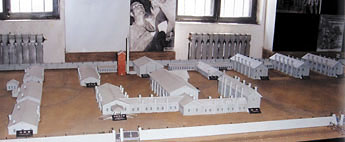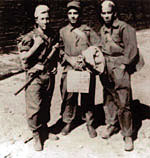|
Death March
Gallup woman visits father's POW camp

A model of the Mukden prison camp where Burrola saw out the war
sits inside one of the two remaining buildings of the camp. [Courtesy
Photo]
By Zsombor Peter
Staff Writer
|

Degoberto Ramirez, Joe Burrola and William Burrola after being
liberated from Mukden, before heading home. [Courtesy Photo]

Willam M. Burrola of the U.S. Army 200th Coast Artillary Batter
D, poses in this photo taken in 1941. [Courtesy Photo]
|
GALLUP — As a child, Rosemary Chavez did not think much of
her otherwise healthy father's occasional trips to the hospital
to have an odd rash looked at. At the time, it was just one more
mystery in an adult world still out of her reach.
There were other anomalies about William Burrola that confounded
his young daughter as well, like the flashes of a stubborn man that
tinged but never overshadowed an indomitably "happy-go-lucky"
spirit.
For most of his adult life, Burrola, a technical sergeant in the
U.S. Army's 200th Coastal Artillery Unit during the Second World
War, spoke sparingly of his service in the Philippines, even less
of his years as a prisoner of war. A survivor of the infamous Bataan
Death March, he spent the last four years and four months of the
war a captive of the Japanese.
"I think after the war they just wanted to forget what they'd
seen, because they'd seen so much death and killing," Chavez
said.
But grandchildren have a way of softening the heart. And when Burrola's
asked about the war for a school project, a 70-year-old man opened
up. As Burrola told them his stories, Chavez listened, and the final
pieces of her father started falling into place. Burrola's death
in 2001 freed up military and medical records that added to the
picture. But it was a recent trip to China, to the prison camp where
her father saw out the war, that let Chavez finish the puzzle.
Bataan to Mukden
A trip to China was the last thing Chavez was looking for while
perusing the latest issue of Quan, a magazine for veterans of the
war. Although her father had passed away years ago, her mother never
let the subscription run out. But when she came across an ad from
the Truth Council for World War II in Asia, a private group out
of North Carolina organizing a May trip to Mukden, Chavez "jumped"
at the chance.
Mukden had played a leading role in her father's war stories, the
northeastern Chinese city where he would serve most of his time.
More than that, it was the final destination of a harrowing journey
that for Burrola and hundreds of other U.S. soldiers started out
on the beaches of Manila Bay.
Burrola and his regiment were stationed on the Philippine island
of Luzon when the Japanese attacked Pearl Harbor in the early morning
hours of Dec. 7, 1941. A few hours later, Japanese planes were strafing
their own positions. American and Philippine forces held out for
the next four months. Finally forced to the tip of Bataan Peninsula,
the Pacific Ocean at their backs, they surrendered April 8. What
followed was a 12-day journey, most of it by foot, that's come down
through history as the Bataan Death March.
Accounts of the precise distance traveled and of the number of prisoners
who perished along the way vary. Roughly 12,000 U.S. troops started
out for Camp O'Donnell, some 70 miles to the north. By the personal
accounts of the soldiers who lived to tell about it, for every one
who survived, two would die.
Burrola's accounts, for all its horror, is typical. Along with photos
and records, Chavez collected them in a three-hole folder she copied
and handed out to family and friends before leaving for China. In
it, Burrola tells of the almost sadistic zeal of his captors. Prisoners
not claimed by exhaustion, thirst, hunger or disease were shot or
stabbed at the slightest provocation or none at all. Prisoners who
refused to bury their comrades alive risked joining them in the
grave. At night, guards would pick out a sick prisoner and mockingly
lunge at him with a bayonet. If the prisoner had the strength to
defend himself, the guards would run him through.
"It was their way of having fun," Burrola said.
On the first day of the march, he watched a Japanese soldier toss
a wounded prisoner in front of a column of tanks. By the time it
passed, he recalled, the prisoner had "disappeared." His
only trace was a uniform pressed into the cobblestone road.
From O'Donnell, the Japanese sent the prisoners to camps across
their new empire. Burrola and his brother, Joe, who also survived
the war, ended up in Mukden.
Life was easier there, but still not easy. Burrola worked long hours,
first at a machine plant, then a leather factory. Bitter winters
replaced the stifling tropical heat of the South Pacific. The cruelty
continued.
"Some of the brutality was just so incredibly senseless,"
said Pat Wang, whose husband K.L. helped found the Truth Council.
She's heard stories of guards ordering prisoners outside in the
dead of winter, to strip naked, circle a distant tree, and put their
cloths back on.
Liberation finally arrived Aug. 15, 1945. Allied forces kept the
prisoners in Mukden for another two weeks before shipping them home.
Past to present
Chavez was surprised to see that a bustling city of millions, renamed
Shenyang, had grown up around the camp when she arrived in late
May. The only reminders of the camp a single-story building of gray
brick for the Japanese officers and a two-story building beside
it that housed the prisoners now sat quietly in the shadows of a
neighborhood full of factories and towering apartment blocks.
Inside the larger of the two buildings, replicas of the beds the
soldiers slept in lie as they did during the war. Inside the other,
a scale model of the camp circa 1942 sits in the middle. Photographs
of camp life adorn the walls. Next to the photos is a list of the
1,494 prisoners who stayed at the camp, including the more than
200 who died there. The names are ordered by prison numbers. Standing
before the board, Chavez scrolled down to 300: William Burrola.
More than a month later, back in Gallup, Chavez holds no anger toward
the Japanese for what they did to her father. What she has, instead,
is a deeper understanding of the man he was.
"I'm getting to understand more why he had the personality
that he had," Chavez said.
The trip, she added, gave her "a small picture of how they
suffered, being brutalized by the Japanese, emotionally and physically."
Paradoxically, it shed light on opposite sides of her father.
There was the fun-loving, easy-going spirit she remembers most.
"When they came home (from the war), they were so close to
death that they wanted to live life to the fullest," Chavez
said.
But there was another side.
"He was stubborn," Chavez said. "I always wondered
why he would say no to everything first, and then he would be OK
with it."
She now sees it as a vestige of the war, a reflexive, if misplaced,
defiance toward taking any more orders.
As for the rash, Burrola's doctors prescribed it to post traumatic
stress syndrome, a phenomenon not recognized until years after the
war.
For Chavez, Mukden helped her connect with the past. For the Wangs,
who've been leading tours to the museum since 2002, it's just as
much about connecting the past to the present.
It's often said that those who don't remember the past are destined
to repeat it. She and her husband, who escaped China before it fell
to the communists in the years leading up to the war, had hoped
that showing people how the Japanese treated their prisoners might
teach other Americans how to treat their own. But the things they
hear and read about Guantanamo and Abu Ghraib give them little hope.
"There's an awful lot of similarities," Pat Wang said.
"We haven't learned our lesson."
|
Weekend
June 30, 2007
Selected
Stories:
Death March;
Gallup woman visits father's POW camp
Wrangler
Rodeo to open
Adults
Gone Wild?; Umpire, coach clash after 9/10 year-old baseball game
Spiritual Perspectives;
They're not Drunks, They're Children of God
Deaths
|



